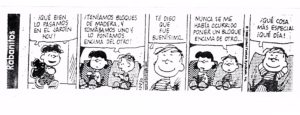Linus comes home from kinder-garden and exclaims that they ”had a very good day today.” He says that they took blocks of wood placed one on top of the other. He exclaims: “It was beautiful.” He goes on to admit that it never would have occurred to him to put one block on top of the other. Then he concludes, as he sits back, smiling: “It was a very special thing. What a day!”
I am so fond of this cartoon because I think it captures the very essence of what it means to learning to think. The act of putting one block on top of the other represents that of coming to understand how one thought or idea can indeed support another. Or, to put it the other way around, how one idea can arise out of another. Linus has discovered how ideas can link together, or support one another.
I often used this particular cartoon strip to illustrate to my beginning philosophy and religion classes how important and exciting learning to see how ideas can hook together, or not, can be. Learning to understand how clear thinking can be distinguished from erroneous thinking is an extremely important lesson, or as Linus put it: “A very special thing.” And it can also be a very special, exciting thing to learn that the one does not happen to support the other. This block, or idea, will or will not, support that idea. This is the very essence of what it means to learn to think.
At a more sophisticated level, this is what a course in logic, or mathematics, or science, or even a course in the principles of colors and shapes in an art can be seen to be about. Here one can substitute almost any subject matter, such as physics, architecture, or even geography, to show that how some things or ideas, can or cannot be combined in various ways and according to various patterns. The point is, to somehow learn to think, to understand what follows from what, and what does not so follow, is the very heart of becoming “educated”, or of “learning.
Finding out which blocks support others and which do not in any given field of endeavor is, to be sure, not always an easy task. Hard thought, trying different angles, and having the patience to follow up on the various options involved does not always, if ever, come easy. In addition, sometimes one has to “walk away” from the topic or subject and do something else, in order to allow things to simmer before they can coalesce into a useful, true solution.
It took me several years of college and some practical experience before I came to understand that I could actually be good at learning itself. I was not anything like a good student until I arrived in my third year of college. Once I realized that I would like to be a college professor, on the basis of some things several professors said about and to me, everything sort of fell into place. My self-confidence grew and so did my classroom performance. I surprised a lot of people by going off to graduate school
The “Aha” moment experienced by our friend Linus sometimes both takes and lasts a while longer. But when things finally come together, when the “Eureka” moment experienced by Archimedes when he grasped the relationship between weight and volume in his bathtub arrives, then the joy of discovery and fresh knowledge experienced by Linus in that moment in his kinder garden classroom. Linus was not bragging, but sharing the pure joy of learning. Occasionally I have been present when this moment arrives for a student in the classroom. What a great joy it is. It is a grand moment whenever we actually LEARN something of significance for the first time. “A very special thing”, said Linus. “What a day!”

2 responses to “PERHAPS MY VERY FAVORITE “PEANUTS” CARTOON”
What a great cartoon!
There is nothing like the moments in philosophy classes when students “get” that they’re not just learning what other people think: They’re entering a more exciting PRACTICE of reasoning, mulling, surmising, revising, and ultimately giving their OWN REASONS in support of what THEY think.
Thanks Brendan – you above almost anybody know how this works :O) Paz, Jerry